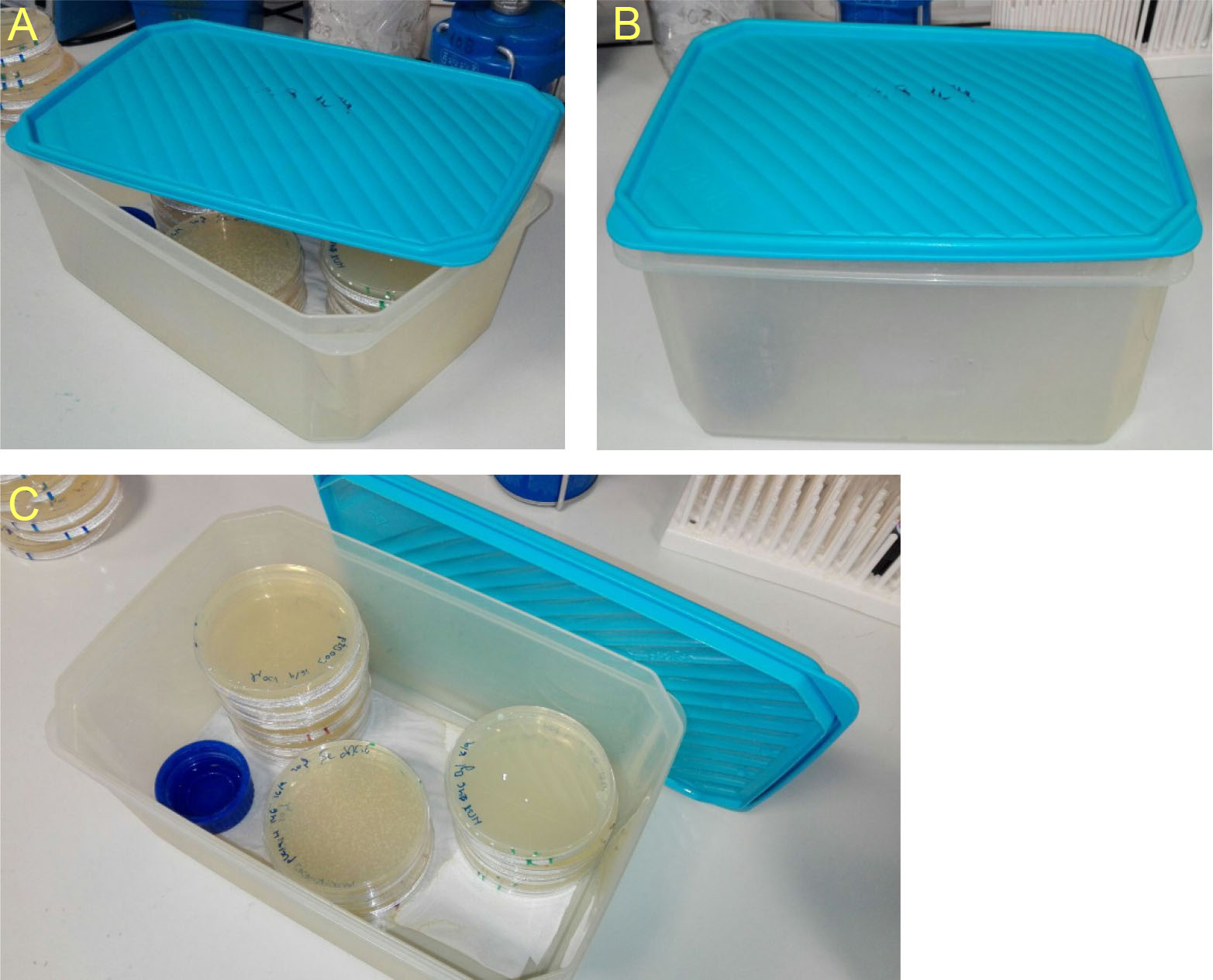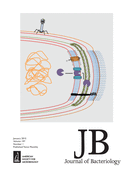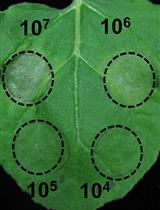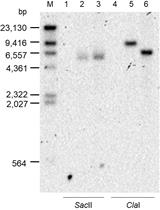- EN - English
- CN - 中文
Cell-to-cell DNA Transfer among Thermus Species
栖热菌属细胞间DNA的转移
发布: 2016年11月20日第6卷第22期 DOI: 10.21769/BioProtoc.2006 浏览次数: 9632
评审: Daan C. SwartsMaria SinetovaAnonymous reviewer(s)
Abstract
The ability to transfer DNA via direct cell-to-cell contact-dependent process similar to conjugation has been described in Thermus thermophilus (Tth). Here, we detail the mating experiment protocol involving the lateral transfer of thermostable antibiotic resistance markers (i.e., kanamycin: KmR; hygromycin: HygR) between Thermus cells, enabling the selection and quantification of the transfer frequencies. Briefly, liquid cultures of both mates are mixed and laid onto a nitrocellulose filter on a TB plate. After incubation at 60 °C, filters are resuspended upon selective plating. The contribution of DNA uptake by transformation is abolished by the addition of DNase I to the mix. This protocol can be used for the transfer of large DNA fragments (> 10 kb) to Thermus species.
Background
Conjugation, as the chief mechanism for horizontal gene transfer for most bacteria, is a highly specialized process by which DNA is transferred between two cells which are in direct contact (Lederberg and Tatum, 1946). Classical conjugation involves the unidirectional transfer of a DNA molecule, generally plasmid-encoded, from a donor to a recipient cell, which remains passive. However, alternative models have been described for a wide variety of bacteria. In the laboratory, conjugation experiments are fruitful for marker-exchange mutagenesis, among others. Over other methods of genetic transfer, conjugation is advantageous in terms of minimal disruption of the bacterial envelope and the feasibility to transfer large DNA fragments, including large chromosomal regions (> 10 kb).
A conjugation-like process among T. thermophilus cells was reported a decade ago, where chromosomal markers were transferred following a high frequency of recombinants Hfr-like process, as evidenced by interrupted mating assays employing liquid mixes of different strains (Ramírez-Arcos et al., 1998). Recently, the model proposed for Thermus thermophilus describes the transfer as a two-step bidirectional process where a functional competence apparatus is required in the recipient cell but not in the donor, bestowing this phenomenon the name of ‘transjugation’ (Blesa et al., 2015). Compared to liquid mating assays aforementioned, transfer frequencies obtained with the protocol described here are higher and more robust. Higher reproducibility of the assays is reached with this protocol compared to mating tests in liquid. Besides, validation of the conjugative transfer is ensured by the addition of DNase.
Materials and Reagents
- Sterile plastic Petri dish plates (standard size; 100 x 15 mm)
- Sterile 1.5 ml microcentrifuge tubes (STARSTEDT, catalog number: 72.690.001 )
- Sterile tips for micropippettes
- Nitrocellulose filters, 0.22 μm (EMD Millipore, catalog number: GSWP02500 )
- Donor and recipient Thermus strains, containing selectable markers (i.e., Thermus sp geneA::kat and Thermus sp geneB::hyg)*
- Tryptone (Conda, catalog number: 1612 )
- Yeast extract (Conda, catalog number: 1702 )
- Sodium chloride (NaCl) (EMD Millipore, catalog number: 1.06404.1000 )
- Agar (grade A) (Conda, catalog number: 1800 )
- Thermus water (carbonate-rich mineral water)
- Appropriate thermostable selectable markers (i.e., kanamycin: KmR; Hygromycin: HygR)**
- Kanamycin sulphate (Sigma-Aldrich, catalog number: K1377-5G )
- Hygromycin B (Sigma-Aldrich, catalog number: BH7772-1G )
- DNase I, grade II from bovine pancreas (1 mg/ml) and its buffer solution (Roche Diagnostics, catalog number: 10104159001 )
- TB liquid medium (see Recipes)
- TB agar plates (see Recipes)
Notes:
- *Several Thermus thermophilus strains such as HB27, NAR1 and HB8, have been successfully employed in mating assays (Ramírez-Arcos et al., 1998; César et al., 2011; Blesa et al., 2015). All parental Thermus strains can be acquired at the DSMZ ollection.
- **Vectors containing thermostable selectable markers are available at RIKEN repository
Equipment
- 50 ml Erlenmeyer flask
- Rotary shaker incubator reaching 70 °C (150 rpm) (Thermo Scientific, Thermo ScientificTM, catalog number: SHKE 420HP )
- Glass plating beads or a spreader
- Autoclave device (CertoClav, model: EL 18L )
- Tweezers (EMD Millipore, catalog number: XX6200006P )
- Vortex Minishaker MS2 (IKA, model: MS2 )
- Spectrophotometer (Hitachi, model: U-2000 )
- Pipette P2, 0.2-2 μl (Gilson, Pipetman classicTM, catalog number: F144801 )
- Pipette P20, 2-20 μl (Gilson, Pipetman classicTM, catalog number: F123600 )
- Pipette P100, 20-100 μl (Gilson, Pipetman classicTM, catalog number: F123615 )
- Pipette P200, 50-200 μl (Gilson, Pipetman classicTM, catalog number: F123601 )
- 70 °C heater (Gemini, model: Memmert UE400 )
- Bench-top microcentrifuge with rotor for 1.5 ml microcentrifuge tubes (Eppendorf, model: Mini Spin® plus )
- Humid chambers
Notes: - Tupperware devices are preferentially used. Humidified plastic bags are also valid.
- Addition of a paper towel, soaked on Thermus water and laid on the bottom of the chamber would enhance humidity maintenance. Ventilation should be avoided in order to conserve humidity. An example is provided in the photographs beneath (Figure 1).

Figure 1. Humid chambers. Descriptive photographs of the humid chambers used to incubate Thermus plates. Place a piece of paper soaked with Thermus water and a bottle cap filled with the same water on the bottom of the chambers to maintain high humidity.
Procedure
文章信息
版权信息
© 2016 The Authors; exclusive licensee Bio-protocol LLC.
如何引用
Blesa, A. and Berenguer, J. (2016). Cell-to-cell DNA Transfer among Thermus Species. Bio-protocol 6(22): e2006. DOI: 10.21769/BioProtoc.2006.
分类
微生物学 > 微生物遗传学 > 转化
分子生物学 > DNA > 转化
您对这篇实验方法有问题吗?
在此处发布您的问题,我们将邀请本文作者来回答。同时,我们会将您的问题发布到Bio-protocol Exchange,以便寻求社区成员的帮助。
提问指南
+ 问题描述
写下详细的问题描述,包括所有有助于他人回答您问题的信息(例如实验过程、条件和相关图像等)。
Share
Bluesky
X
Copy link












